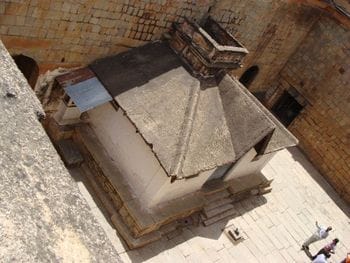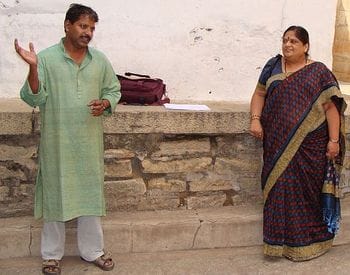The morning of Sunday, 22 June, saw a motley bunch of people assemble at the entrance to Bangalore Fort. Architects, housewives, techies, photographers, writers and scientists, among others, gathered to learn more about Bangalore’s heritage and its past from one of the city’s leading historians, Dr S K Aruni. The event was organised by the Bangalore chapter of the Indian National Trust for Art and Cultural Heritage (INTACH) as part of its Parichay (meaning ‘introduction’) programme, an initiative aimed at raising awareness of Bangalore’s heritage among its citizens.

Participants in the INTACH Parichay event at the Bangalore Fort. Pic: MB Rajani
Dr Aruni, Assistant Director of the Southern Regional Centre of the Indian Council of Historical Research, began with a brief sketch of Bangalore’s history. Starting from 3,000 years ago when Neolithic settlements flourished in and around the city, Dr Aruni led the group through the succeeding centuries to the time when the Yelahanka Prabhu, Kempe Gowda, established a fort in the 1500s.
Armed with maps, sketches and his phenomenal knowledge of the area, Dr Aruni provided his own perspective on the Fort, the Pettah and the vicinity. Contrary to the established view, he believes both the oval fort and the Pettah area were probably built at the same time, and that the oval fort design might have been inspired by the fort layout at Bidar, then one of the most important cities in the region.
After the history recap, the group had a look around the fort. Thanks to permission from the Archaeological Survey of India (ASI), the participants were also able to see the rooms in the Fort where English prisoners such as David Baird were held by Hyder Ali and Tipu Sultan in the 1780s.

The 16th century Ganesha temple inside the Bangalore
Fort, as seen from the ramparts.
Pic: INTACH, Bangalore
The group then walked over to the ‘abode of happiness and the envy of heaven,’ Tipu’s Summer Palace. Group members were treated to a sumptuous breakfast here, courtesy the ASI, and then moved to the adjacent Kote Venkataramanaswamy temple, where Dr Aruni pointed out some salient features of the temple, including the exquisite frieze along the outside walls depicting the marriage of Shiva and Parvati, and the four-sided pillars with gargoyles, said to be unique in Karnataka. Dr Aruni also showed the group some of the defaced pillars in the temple which suggested that the Vaishnavite temple had had a Shaivite past.
The three-hour Parichay ended at the dilapidated Tipu Armoury, behind Bangalore Medical College, where H R Prathibha, convener of INTACH, Bangalore chapter, spoke to the group about the structure, its importance and efforts to get it restored and protected.
In keeping with its name, for most participants, the Parichay event did indeed serve as an introduction to Bangalore’s past. Most participants – Bangaloreans all – were surprised by how little they knew of their city’s heritage. Some had not known about the fort at all; many had been to the Kote Venkataramanaswamy temple before but had not known about its unique features, others had driven past the temple several times but had never realized that it had such a rich history.

Dr S K Aruni and H R Prathibha, of INTACH, Bangalore chapter.
Pic: INTACH.
Almost none had been to the Tipu Armoury, which uniformly elicited reactions of dismay at the depredation inflicted on it. R Jegannathan, a former professor of architecture, wryly observed, "Soon, this will become the basement car park of a mall which will be named ‘Tipu Armoury Mall’, shortened to TA Mall, and then nobody will remember that there was ever such a structure here."
Perhaps. But that is precisely the sort of development that INTACH hopes to prevent by creating awareness about Bangalore’s heritage. ⊕